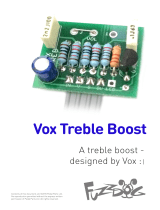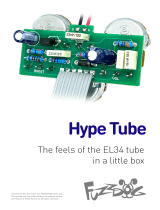Page is loading ...

Mutant Fuzz
Regulus VIII Fuzz with mods
Contents of this document are ©2015 Pedal Parts Ltd.
No reproduction permitted without the express written
permission of Pedal Parts Ltd. All rights reserved.

Important notes
If you’re using any of our footswitch daughterboards,
DOWNLOAD THE DAUGHTERBOARD DOCUMENT
•Download and read the appropriate build document for the daughterboard
as well as this one BEFORE you start.
•DO NOT solder the supplied Current Limiting Resistor (CLR) to the main
circuit board even if there is a place for it. This should be soldered to the
footswitch daughterboard.
POWER SUPPLY
Unless otherwise stated in this document this circuit is designed to be
powered with 9V DC.
COMPONENT SPECS
Unless otherwise stated in this document:
•Resistors should be 0.25W. You can use those with higher ratings but
check the physical size of them.
•Electrolytics caps should be at least 25V for 9V circuits, 35V for 18V
circuits. Again, check physical size if using higher ratings.
LAYOUT CONVENTIONS
Unless otherwise stated in this document, the following are used:
•Electrolytic capacitors:
Long leg (anode) to square pad.
•Diodes/LEDs:
Striped leg (cathode) to square pad. Short leg to square pad for LEDs.
•ICs:
Square pad indicates pin 1.

Schematic
BOM
R1 2M2
R2 3M3
R3 2K2
R4 1M
R5 1K
R6 22K
R7 2K2 (CLR)
C1 47p
C2 4n7
C3 100n
C4 470p
C5 10u elec
C6 47u elec
C7 2u2 elec
T1 4K7 Trim
Q1-2 BC109*
D1-2 1N4148
D2 1N4001
BODY** 100KA
VOL 100KB
CLIP** 5KB
*Other NPN transistors can be used. Experiment. 2N3904 and 2N3565 work well.
**BODY and CLIP are optional. If you prefer to keep to the original do the following:
TO OMIT BODY TO OMIT CLIP
•Leave out C5 • Leave out CLIP pot and place
•Leave out BODY pot a jumper between pads 2 and 3
There are extra pads marked 1 and 2. These enable you to take the clipping diodes out of the
circuit altogether. To do that add a SPST or SPDT toggle switch. Connect one pad to the centre
lug, the other to either of the outer lugs (or the single outer lug if using SPST).
If you aren’t adding the switch, jumper pads 1 and 2 together.
Use the trimmer T1 to dial in the sweet spot. There’s no precise voltage to aim for - just adjust
until it sounds awesome.

The power and signal pads on the PCB conform to the FuzzDog Direct Connection format, so can
be paired with the appropriate daughterboard for quick and easy offboard wiring.
Be very careful when soldering the diodes, LED and transistors. They’re very sensitive to heat. You
should use some kind of heat sink (crocodile clip or reverse action tweezers) on each leg as you
solder them. Keep exposure to heat to a minimum (under 2 seconds).
The striped leg (cathode) of the diodes go into the square pads.
The long leg (anode) of the electrolytic capacitors go into the square pads.
Snap the small metal tag off the pots so they can be mounted flush in the box.
Pot mounts on the back side of the board. You can use vertical-mount pots or just wire up ‘normal’
ones. It’s a good idea to place the pots in their holes in the enclosure when you’re soldering them in
place on the PCB. That way you know they’re going to line up ok. Best way to do it is to solder a
single pin of each pot in place, then do a visual check to see that they’re all sitting at the same
height. If not, melt the joints and readjust any that are off.
If your pots don’t have protective plastic covers
you should place a strip of thick card between
them and the board when soldering to keep
them a good distance from the pcb to avoid
shorting other components.
You should solder all other board-mounted
components before you solder the pots. Once
they’re in place you’ll have no access to much of
the underside of the board.
PCB Layout ©2015 Pedal Parts Ltd.

Test the board!
Check the relevant daughterboard document for more
info before you undertake this stage.
UNDER NO CIRCUMSTANCES will troubleshooting help
be offered if you have skipped this stage. No exceptions.
Once you’ve finished the circuit it makes sense to test is before starting on the switch and LED
wiring. It’ll cut down troubleshooting time in the long run. If the circuit works at this stage, but it
doesn’t once you wire up the switch - guess what? You’ve probably made a mistake with the switch.
Solder some nice, long lengths of wire to the board connections for 9V, GND, IN and OUT. Connect
IN and OUT to the jacks as shown. Connect all the GNDs together (twist them up and add a small
amount of solder to tack it). Connect the battery + lead to the 9V wire, same method. Plug in. Go!
If you’re using a ribbon cable you can tack the wires to the ends of that. It’s a lot easier to take them
off there than it is do desolder wires from the PCB pads.
If it works, carry on and do your switch wiring. If not... aw man. At least you know the problem is
with the circuit. Find out why, get it working, THEN worry about the switch etc.
Your completed circuit board
including pots

(if using a daughterboard please refer to the relevant document)
Wire it up - DC only version
This circuit is standard, Negative GND. Your power supply should be
Tip Negative / Sleeve Positive. That’s the same as your standard pedals
(Boss etc), and you can safely daisy-chain your supply to this pedal.
The BOARD GND connections don’t all have to connect to one point.
They can be daisy-chained around the circuit, using larger connection
points (such as jack socket lugs) for multiple connections. As long as
they all connect together in some way.
L
E
D
BOARD
OUT
BOARD
9V
BOARD
GND
BOARD
GND
BOARD
GND
BOARD
INPUT
+
IN
OUT
L
E
D
BOARD
GND
BOARD
LED+

(if using a daughterboard please refer to the relevant document)
Wire it up - with battery
This circuit is standard, Negative GND. Your power supply should be
Tip Negative / Sleeve Positive. That’s the same as your standard pedals
(Boss etc), and you can safely daisy-chain your supply to this pedal.
The BOARD GND connections don’t all have to connect to one point.
They can be daisy-chained around the circuit, using larger connection
points (such as jack socket lugs) for multiple connections. As long as
they all connect together in some way.
L
E
D
BOARD
OUT
BOARD
9V
BOARD
GND
BOARD
GND
BOARD
GND
BOARD
INPUT
BATTERY
+
IN
OUT
L
E
D
BOARD
GND
BOARD
LED+
+
Just because the
FuzzDog enclosure
won’t take a battery,
there’s nothing
stopping you using a
bigger box.

Drilling template
Hammond 1590B
60 x 111 x 31mm
Stinky Cheese
Recommended drill sizes:
Pots 7mm
Jacks 10mm
Footswitch 12mm
DC Socket 12mm
Rotary Switch 9mm
This template is a rough guide only. You should ensure correct marking of your
enclosure before drilling. You use this template at your own risk.
Pedal Parts Ltd can accept no responsibility for incorrect drilling of enclosures.
FuzzDog.co.uk
It’s a good idea to drill
the holes for the pots
8mm to give yourself
some wiggle room
unless you’re a drill ninja
32mm
22mm
/










